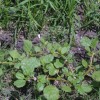Abstract
Horse purslane and common purslane are broadleaf weeds associated with sugarcane fields in muck (organic) and mineral soils of South Florida. Growers often confuse these two weed species with each other. However, these two species have distinct phylogenetic (evolutionary) and morphological differences. This 4-page fact sheet was written by Dennis Calvin Odero, Ron Rice, and Les Baucum, and published by the UF Department of Agronomy, January 2013.
References
Balyan, R.S., and V.M. Bhan. 1986. "Emergence, Growth, and Reproduction of Horse Purslane (Trianthema portulacastrum) as Influenced by Environmental Conditions." Weed Science 34: 516-9. https://doi.org/10.1017/S0043174500067345
Southern Weed Science Society (SWSS). 1993. Weed Identification Guide. Champaign: Southern Weed Science Society.
“Trianthema portulacastrum L. - AIZOACEAE – Dicotyledon.” Accessed November 10, 2012. http://www.oswaldasia.org/species/t/trtpo/trtpo_en.html.
United States Department of Agriculture, Natural Resources Conservation Service (USDA-NRCS). 2012. “Portulaca oleracea L. little hogweed.” Accessed November 10, 2012. http://plants.usda.gov/java/profile?symbol=POOL.
USDA-NRCS. 2012. “Trianthema portulacastrum L. desert horsepurslane.” Accessed November 10, 2012. http://plants.usda.gov/java/profile?symbol=TRPO2.
Uva, R.H., J.C. Neil, and J.M. DiTomaso. 1997. Weeds of the Northeast. Ithaca: Cornell University Press.
Vengris, J., S. Duann, and M. Stacewicz-Sapuncakis. 1972. “Life History Studies as Related to Weed Control in the Northeast. 7 – Common Purslane.” Northeast Regional Publication. Research Bulletin 598. Amherst, MA: The University of Massachusetts, Amherst, College of Food and Natural Resources, Agricultural Experiment Station.
Unless otherwise specified, articles published in the EDIS journal after January 1, 2024 are licensed under a Creative Commons Attribution-NonCommercial-NoDerivs 4.0 International (CC BY-NC-ND 4.0) license.

